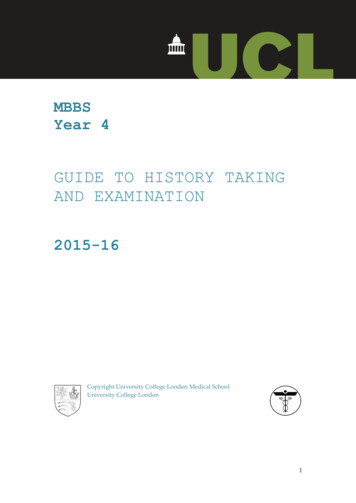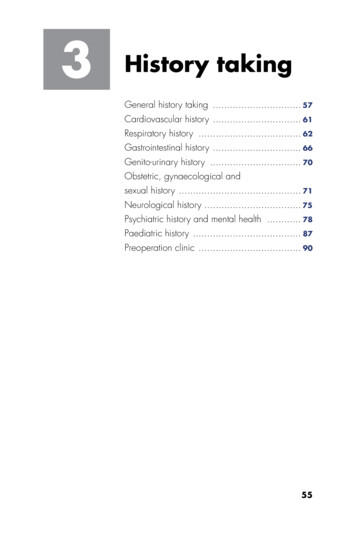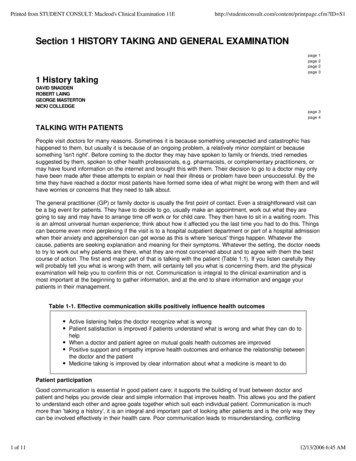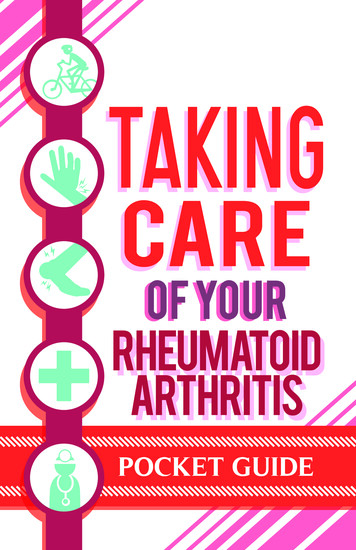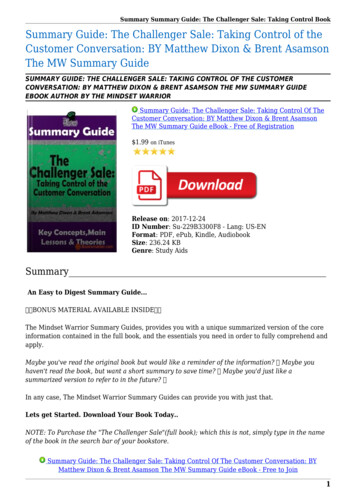
Transcription
Taking the Pulse on Information GovernanceMarch 3, 2016Deborah K. Green, RHIA, MBA , EVP/Chief Innovation and Global Services OfficerKatherine Downing, MA, RHIA, CHPS, PMP, Sr. Director Information Governance
Conflict of InterestDeborah K. Green, RHIA, MBA , EVP/Chief Innovation and Global Services OfficerKatherine Downing, MA, RHIA, CHPS, PMP, Sr. Director Information GovernanceHave no real or apparent conflicts of interest to report.
Agenda Information Governance is a business imperative forhealthcare – let’s talk about the reasons why IG PulseRate - a quick check into an organizations IGmaturity.– Review findings from over 500 organizations– Discuss areas where organizations are succeeding withinformation governance– Discuss the types of organizations using IG PulseRate quarterly for maturity scoring– Discuss “what’s next” for IG Adoption Modelmeasurement
An Introduction of How Benefits Were Realized for the Valueof Health ITInformation Governance – Realizing theValue of Health ITSavings in Storage/Life Cycle Managementand Risk / Breach PreventionPatient Engagement / Reliable data andinformation for moving to Population HealthPrivate, Secure Data and InformationInformation Available where and when it isneeded for TreatmentSecure Patient Interactions and TrustworthyInformation to Support Patient Portalshttp://www.himss.org/ValueSuite
Challenges to Ensuring Trust in ourInformationRapid adoption of disruptive technologiesRapid eSystem’s adoption . Rapid growth of devices . Explosion of Data /Data Sources. Failure to agree on rules and standards on how we documentin eEnvironment. Failure to adopt and use interoperability standards. Failure toaddress patient care flows, work flows in systems implementation. Failure togovern our systems implementations. Failure to govern our data and information.Focus on the Technology and not the Information.
Data and Information The Water in our Healthcare EcosystemInformation Governance,A Healthcare Ecosystem ImperativeAHMA.ORG/INFOGOV
What WillTrust in Our Information Enable?Safe Use of Health ITRight Patient – Right InformationQuality Care - Lower CostsReliable Performance MeasuresProof of the Value of Care PurchasedTrust in Exchange PartnersReliable AnalyticsA Learning Health SystemResearchReliable Data for Population HealthAppropriate & Ethical Use of InformationA State of InteroperabilityReduced Information Risk
AHIMA: Leading InformationGovernance for Healthcare Awareness & AdvocacyConvening and CollaborationCollaborationTraining & EducationPrinciples: IGPHC *Surveys – White PapersIG ToolkitIGAM IG Assessment Tools andTechnology Aids*Adapted from AHIMA International ‘s GenerallyAccepted Recordkeeping Principles, ARMA.org AHIMA.ORG
AHIMA: Leading InformationGovernance for HealthcareAHIMA DefinitionAn organization-wide framework formanaging information throughout itslifecycle and for supporting theorganization’s strategy, operations,regulatory, legal, risk, andenvironmental requirements. AHIMA.ORG
Information Governance forHealthcare – Tenets of AHIMA’s IG It must be organization-wide It applies to all types of data and information It applies to data and information in/on all types ofmedia It must be implemented across the healthcareecosystem, i.e. by any information intensivehealthcare organization. Information governance is an ethical obligation of anyinformation intensive organization in healthcare
Information Governance forHealthcare – Tenets of AHIMA’s IG Information Governance requires the adoptionof Principles to guide decisions about howinformation is governed. An organization’s ability to become mature init’s adoption of Information Governancerequires mastery of essential Competencies inIG. Organizations should assess their competencylevels and establish goals for competencylevels needed given their strategy, mission, roleand resources.
Information GovernanceFor HealthcareStrategicAlignmentDGIG Principles ForHealthCare *:IG CompetenciesFor rategic AlignmentIG StructuresDGEIMITGAnalyticsPrivacy & SecurityRegulatory & LegalAwareness & AdherenceIG PerformanceITGEIM*Adapted from AHIMA International ‘s GenerallyAccepted Recordkeeping Principles, ARMA.org AHIMA.ORG
Core IGProgramComponents Enterprise IT InfrastructurePlanningIT Governance Framework(s)AdoptionIT Governance Scoped forEvolving Changes in PlatformsIT Execution per Best PracticesEnterprise InformationPlanning & ExecutionInformation Organization &ClassificationElectronic Document,Record, & Content MgmtInformation Lifecycle MgmtInformation ProtectionAppropriate UseInformation Sharing,Release, ExchangeChain of CustodyLong-Term DigitalPreservation 2016 AHIMA - Confidential Enterprise InformationPlanningEnterprise DataPlanningEnterprise IT PlanningData and InformationOrganization &ClassificationMaster Data MgmtTaxonomies MgmtMetadata Mgmt Enterprise DataPlanningData Quality Controland Quality MgmtData CategorizationMaster Data MgmtTaxonomies MgmtMetadata MgmtData Dictionary MgmtData Lifecycle Mgmt
IG Adoption –Findings of Two Surveys 2015AHIMA SurveyCapgemini Survey 1260 Respondents, AllHealthcare, Predominantly US 44% Have established IGoversight bodies and 16% inprocess of establishing them 36% Have designated seniorexecutive sponsors 38% Have included IGobjectives in strategic goals 44% Report modest orsignificant IG progress 1,000 Respondents,9 Industries,10 Countries 43% Restructuring to ExploitData Opportunities 33% Have Appointed a CLevel Leader and 19% ofRespondents Will Do sowithin 12 monthsSource 2015 Cohasset Associates AHIMA InformationGovernance in HealthCare, Professional Readiness andOpportunitySource: Ralf Teschner, Capgemini Blog, 3/12/15 –CDO IS IG IR IE
IGPulseRate Organization Summary Free, quick check intoIG maturity available atwww.IGIQ.com Over 500 organizationshave participated Organizations scoringat all levels of IGmaturityPulseRate Level 1PulseRate Level 2PulseRate Level 3PulseRate Level 4PulseRate Level 5
Business DrivenLevel 5Level 4Level 3IT DrivenLevel 2Level1AHIMA’s IG Adoption ModelFragmentedHolistic AHIMA.ORG
IGAM Maturity LevelsLevel 1 This level indicates an environment where information governanceconcerns, requirements, and opportunities are not addressed at all, areaddressed minimally, or are addressed in an ad hoc manner. Organizations that identify primarily with these descriptions should beconcerned that their programs will not meet legal or regulatory scrutiny,may not effectively serve the business needs of the organization, andmay impede patient care and service delivery.Level 2 This level indicates that an organization is in the early stages ofinformation governance. The approach is siloed at the business unitlevel. Organizations that identify primarily with these descriptions should beconcerned that their programs will not meet legal or regulatory scrutiny,may not effectively serve the business needs of the organization, andmay impede patient care and service delivery. There is also an increasedrisk for adverse outcomes and privacy breach.Organizations are encouraged to consider taking an enterprise approachor perhaps developing a roadmap that will help to address vulnerabilitiesand improve management through information governance.
IGAM Maturity LevelsLevel 3 This level indicates a program where the essential requirements thatmust be addressed to meet the organization's legal, regulatory, andbusiness requirements are present in basic form. This approach is characterized by defined policies and procedures andthe implementation of processes specifically intended to improveinformation governance. Organizations that identify primarily with Level 3 descriptions still may bemissing significant opportunities for streamlining business, improving thecare experience, and controlling costs, but they have the key basiccomponents of a sound program in place and are likely to be at leastminimally compliant with legal, operational, and other responsibilities.Level 4 This level describes an organization that has established a proactiveinformation governance program throughout its operations. Informationgovernance issues and considerations are routinely integrated intobusiness decisions. The organization is compliant with good practice and easily meets itslegal and regulatory requirements.
IGAM Maturity LevelsLevel 5 This level describes an organization that has integrated informationgovernance into its overall infrastructure and business processes tosuch an extent that compliance with program requirements and legal,regulatory, and other responsibilities are routine. This organization has recognized that effective informationgovernance plays a critical role in patient outcomes and consumerservices and cost containment, competitive advantage, and patientand consumer service, and it has successfully implementedstrategies and tools to achieve these gains on a integrated basis. This organization is a leader in building and sustaining a vibrant,secure, and ensuring information is trustworthy and actionableacross the medical ecosystem.
IGPulseRate Organizations by TypeEntity PercentageACO5%University / TeachingMedical Center5%Vendor /BusinessAssociate /Law Firm10%HIE /RHIO5%HomeHealth5%Hospice2%Public Health Entity2%Multi-Facility Entity2%Hospital26%Integrated DeliveryNetwork38%
IGPulseRate Users by Role
Decision-making throughout the organization isdata-driven. The source of truth for all data andinformation used for critical business operationsand decisions is established12345
Information Governance in our Organization isEnterprise Wide12345
We have formally committed to a strategyfor information governance and we have adocumented IG plan in place forimplementing and maintaining our strategy.12345
My organization can account for the continuity ofinformation creation, possession, transfer, controland disposition to ensure information integrity andtrustworthiness12345
Measuring Organizational Maturity usingAHIMA’s IG Adoption Model IGHealthRate is the healthcare industry standardmodel for assessing information governancematurity aligned with AHIMA’s InformationGovernance Adoption Model (IGAM). IGHealthRate assesses and scores organizationsusing 10 IG organizational competencies. Each competency includes several key markersthat identify critical requirements that must be metto achieve maturity in information governance.Booth # 12318
Information Governance AdoptionModel for Healthcare (IGAM)IG StructureAwareness &AdherenceStrategicAlignmentEnterpriseInfo MgmtPrivacy manceLegal andRegulatoryDataGovernanceAnalyticsITGovernance
AHIMA Products and Services Supporting IGin Healthcare – www.IGIQ.com IGPulseRate IGHealthRate IGAdvisors IG Leadership Forum (DC, Denver, Baltimore) IG BootCamps (Dallas, Orlando, Chicago, Portland) IG Adoption Maturity Validation IG White Papers IG Toolkit
A Summary of How Benefits WereRealized for the Value of Health ITInformation Governance – Realizingthe Value of Health ITSavings in Storage/Life Cycle Managementand Risk / Breach PreventionPatient Engagement / Reliable data andinformation for moving to Population HealthPrivate, Secure Data and InformationInformation Available where and when it isneeded for TreatmentSecure Patient Interactions andTrustworthy Information to Support PatientPortalshttp://www.himss.org/ValueSuite
Information Governance for HealthCareReferences and Recommended Reading AHIMA. “Information Governance Principles forHealthcare ” 2014. Chicago, IL. AHIMA, 2014.Available at: www.ahima.org/infogov ARMA International. “Generally AcceptedRecordkeeping Principles”.ARMA International, 2013. Available atwww.arma.org Cohasset Associates and AHIMA. “A Call toAdopt Information Governance Practices.” 2014Information Governance in Healthcare.Minneapolis, MN Enterprise Health Information Management andData Governance, 2015. Merida L Johns, PhD,RHIA Information Governance – Concepts, strategies,and Best Practices. 2014. Robert F. Smallwood The Information Governance Initiative. “TheInformation Governance Initiative Annual Report”.2014. New York, NY. www.IGinitiative.com IGI Annual Report 2015 Information GovernanceInitiative 2015 Survey available itiative-publishes-industrys-most-comprehensive Cohasset Associates, 2015. Cohasset Associatesresearch-report/and AHIMA. “Professional Readiness andOpportunity” 2015 Information Governance inHealthcare. Minneapolis, MN. CohassetAssociates, 2015 Implementing Health Information Governance,2015. Linda Kloss, MA, RHIA, FAHIMA The Sedona Conference. “Commentary onInformation Governance” The SedonaConference Working Group Series. A project ofThe Sedona Conference Working Group onElectronic Document Retention and Production(WGI)
Questions
Information Governance for Healthcare – Tenets of AHIMA’s IG Information Governance requires the adoption of Principles to guide decisions about how information is governed. An organization’s ability to become mature in it’s adoption of Information Governance
